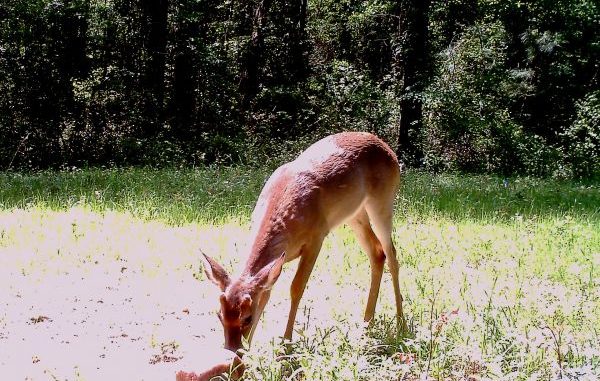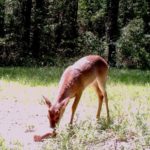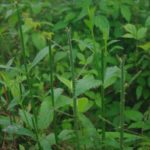
Rains have produced lush habitat
Well, it’s not gold, but to a deer manager, habitat with an understory of lush, desirable native deer plants is just as good as gold.
You have heard it since you were a kid, “April showers bring May flowers.” Well, in this case the April showers all across Louisiana have resulted in an abundance of native plant growth, much of which is desirable browse for deer.
I first noticed it as I was turkey hunting on our property. The honeysuckle growth was exceptional, more than I have ever seen.
Rubus sp., the plants we commonly call blackberry and dewberry, was also abundant and loaded with flowers. The growth in my planted deer strips, primarily chickory and clover, was also exceptional thanks to the abundance of rain.
I pointed out to my son Ruffin one day how deer were walking along the edges of the strips, nipping the clover stems along with an occasional leaf of chickory.
The browse abundance really became apparent when I got on the tractor after a few days of sunshine to clip some strips through the tall vegetation in preparation for the turkey and quail hatch. Looking down from the tractor seat at the vegetation, the browsing activity was readily visible.
I had planted numerous plum seedlings that were quite branchy and were not visible due to the tall grass; I had not caged them, and they were being hammered by the deer.
Hopefully they will continue to grow and at some point overcome the browsing.
A strip of Bumelia sp. seedlings was also being crunched on by the deer. Now Bumelia is not a great deer browse — just a different species of tree I wanted on the property that I had grown from seeds in pots and then set out in the big field. Apparently the deer were finding them quite tasty.
Elderberry was also being eaten, and some of the stems being browsed were as large as a finger.
As I was checking strips across the big power line right-of-way the browsing on honeysuckle, blackberry, dewberry, Verbena, Aster and pepper-vine was more than I have seen in a while. Hopefully this translates to a few more deer running around next fall during the hunting season.
This area is all native vegetation and, again, the strips are primarily cut for the game birds — but no doubt the rabbits benefit from it as do the deer.
Clipping in a checkerboard fashion is a long-standing habitat management activity.
One herbaceous forb that is a very desirable browse plant that I saw chomped on was Lactuca, wild lettuce. This plant makes a tall stem that is hollow and very succulent. Deer love it, and it is generally heavily browsed wherever it occurs. If it was possible to grow enough of this plant to collect seed for the market, someone could make a fortune selling this native forage.
Now, our property is in East Feliciana Parish in Southeast Louisiana, but I have been up the I-49 corridor to Desoto Parish and to Bossier Parish. In Desoto, the growth of honeysuckle and blackberry is also tremendous.
This site has a good deer population, but with so much growth of the desirable deer species over-browsing was not evident.
The same is true for the site in Bossier Parish. This 10,000-acre tract also has a good deer population. The site is dominant pine plantation timber, and deer growth and development is limited.
During winter months, the heavy browsing is quite evident, but after the heavy rains in April the plant growth was tremendous and over-browsing was not apparent — except for when a cluster of greenbriar, honeysuckle or rattan vine was over-hanging along a road or trail. Then browsing was quite evident; at several locations deer had literally eaten every leaf within reach, leaving only a cluster of leafless woody vines.
Small eat-outs such as this are an indication of high deer numbers.
Greenbriar (Smilax sp.) is a very desirable deer browse plant, and on this site the growth this spring is tremendous.
What does all this desirable native deer browse across the landscape equate to?
With the exceptional mast crop we had this year, deer fared quite well during the winter months and should have been able to stay in good physical condition despite the energy used up during the winter and during the rut.
Now that we are well beyond green-out, the native forages that are in such abundance should provide the nutrition for quality growth and development.
The fawning season has begun in Area 2, and does should be able to obtain the necessary nutrition for growing fawns without having the added stress from poor habitat conditions. Likewise, bucks that have begun growing their next set of antlers should have quality nutrition readily available.
Of course, the key for this desirable growth to continue is for the rainfall to continue into the summer months. During the last week of April, rain was still falling in Louisiana, so soil moisture should be more than adequate for plant growth to continue in May.
The question is what will happen during the hot days of summer? June and July are also important months for body and antler growth, and does in the late-rut deer areas will begin dropping their fawns in July and August.
The end of May would be the time to begin thinking about planting some summer forages to supplement the native browse, should rainfall be limited.
Of course, June would be the month to start planting crops for game birds like turkeys, quail and doves. Browntop millet and sunflowers are as good as it gets for these species, while peas and beans are the ticket for deer.
The pig population in our area seems to be way down from what it was two years ago, and I am thinking that a site planted with chufa might be ideal for the turkeys.
Chufa is a grass-like plant (a sedge) that grows and produces underground tubers that, during the late winter, are scratched up and eaten by the turkeys.
Hogs will root up a chufa patch overnight, but with their numbers down it might be worth pursuing.
This is the time of year when hunters begin asking about minerals for deer.
Most of the minerals deer need comes from the foods that they consume during their daily activities. Research has not shown much benefit from making mineral sites for deer.
However, deer do visit the mineral sites, and this is an ideal way to document antler growth of a few bucks during the summer. Does need sodium for milk production, and will frequent the sites more than the bucks.
Once fawns begin following the does, the whole family group will visit the sites.
By fall, the visits to mineral sites decline and other than some days in October, hunting over minerals is usually not productive. The Trophy Rock product that is marketed attracts deer, and they seem to use it regularly.
If you make a site, be sure to use a product that has a good percentage of calcium and phosphorus, along with trace minerals. Avoid using straight salt (NaCl).
However, the trace mineral salt that is available from the seed stores could be used along with calcium and phosphorus to make a mineral site, mixing it with the soil or pouring it on some rotting logs.
While the fishing has been exceptional, if you hunt deer you might want to take some time and visit the woods and look at the browsing activity on the habitat. It might give you some insight as to what to expect when the season opens — and you might find an area with tremendous native browse that is not being hunted and is just waiting for you and your deer stand.




